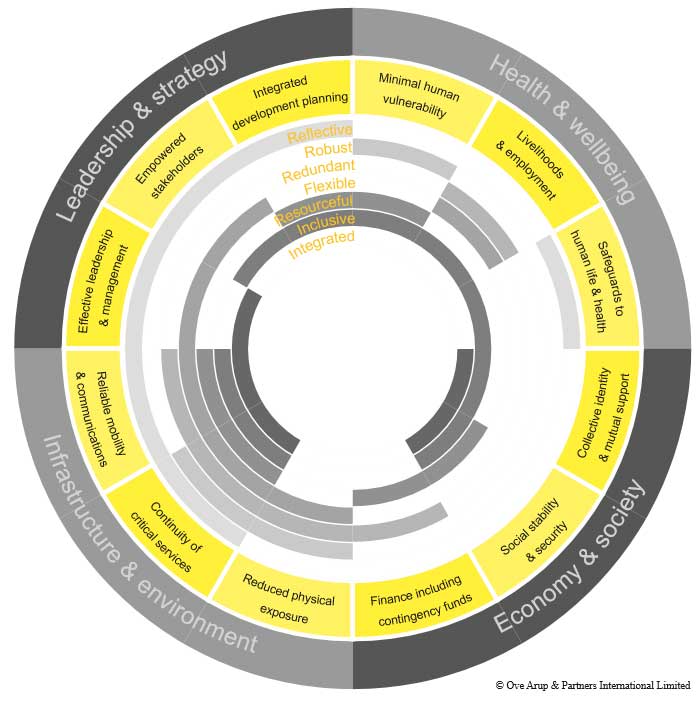-
Phone Number
-
Email Address
If we look at history, the Urban resilience is nothing new, the Societies have evolved by adapting, adopting elements of resistance, creating and reinventing itself to be able survive periods of crisis, are cities that manage to overcome disasters .
Nowadays we live in a multidimensional crisis (ecological, environmental, energy, economic...) that in a foreseeable will manifest itself with singular intensity in the urban environments.
The term resilience and its strategies (diversity, learning capacity, innovation and adaptation, self-organization and self-sufficiency) can give us clues as to what way to reduce urban vulnerability to scenarios of unfavorable future.
In the same line, an article of interest on how to evaluate the urban sustainability with indicators and criteria for the city.
Content menu:
The concept of resilience actually encompasses many aspects, it has a variety of synonyms and depending on which subject matter is assigned a more specific definition and adapted to the sector or situation.
The word has its origin in the Latin language, in the term resilio which means to go back, to return from a jump, highlight, bounce and strength. The definitions common questions of what is resilience from a ecological and urban perspective are:

Calm down!… This is a little review to clarify concepts. This is where the interesting thing begins!
One of the most relevant issues in the urban landscape is determine how to develop more resilient cities where different terms such as sustainable urbanism or the resilient architecture , trying to answer a question unintentionally affects us all . .. Why invest in disaster risk reduction? or are there really that many? natural disasters?
Two graphs on the evolution of natural disasters tell us can prove the existence of what is going on:
We can see the updated graphics from HERE from World in Data.
Not that we intend to "scare" the reader of the article according to data displayed in graphs, but the reality is that the trend is not good and therefore So much must be done .
The social and environmental models of development as well as the inconsistent urbanism can increase exposure and vulnerability of a given city or local area, for therefore can aggravate the risk of a disaster. We could summarize it in the following equation:
Cities and urban areas are made up of thick and complex service systems; and as such, as interconnected elements produce inconveniences that contribute to disaster risk. can be apply strategies and policies to minimize the impact determining a series of risk factors:
Among the different risk factors in large cities is the rise in sea level that will undoubtedly affect cities and towns coastal.
To better understand the possible advance of the sea, there is a world flood map where we can Observe the possible changes according to the increase in temperature... HERE. (We can search for any city in the world)

By the way, speaking of maps, there is a program to make street sketch very simple and you can find any city of the mute.
From the 100 Resilient Cities portal, there have been dedicated to the study and behavior of cities getting a wheel of indicators. Provides a lens to understand complexity of cities and controllers who contribute to their resilience within the concept of resilience of cities .
Regarding these indicators can help companies cities to assess the extent of their ability to recovery, to identify critical areas of weakness, and to identify action and programs to improve the resilience of the city.

We can learn more from the Arup Report… Here.
In general, the purpose of being resilient is universal, an ideal at the individual level, organizational and/or community. The great diversity of actors that are part of the complex social fabric of a city are requires joint action. The reduction of disaster risk is an integral part of the dimension environmental, social and political development sustainable . (We can understand more in the sustainable development article)
The different main levels of a society act modern like; The political, social, economic and environment.
In this sense, from a report issued by United Nations United States for disaster risk reduction called “How to make cities more resilient” propose an infographic that presents the ten aspects or pillars that cities should meet:
One of the largest portals that deals with the subject at a national level International is the Global Facility for Disaster Reduction and Recovery (GFDRR) where we can find a lot of information and different documents of interest.
In this sense we can find many projects and examples that address the theme, mainly intended for the urban development and its landscape aimed at natural systems that prevent or minimize risks. (See also water drainage and its planning).

In many countries of the world the weapon of reinventing yourself is the simple fact of survival of many people An example is found in the Sahel, where hunger reigns at its wide.
Some 11 million people are threatened by the lack of food in the «hunger season» (Between June and September), more than a million children die as a result of their most extreme consequence, of malnutrition acute.
From this document we delve into security food and that we can see clearly in the following schema:
You can also access our catalog – compilation of manuals on design of urban spaces with more than reports notable and quality to expand the information in urbanism.